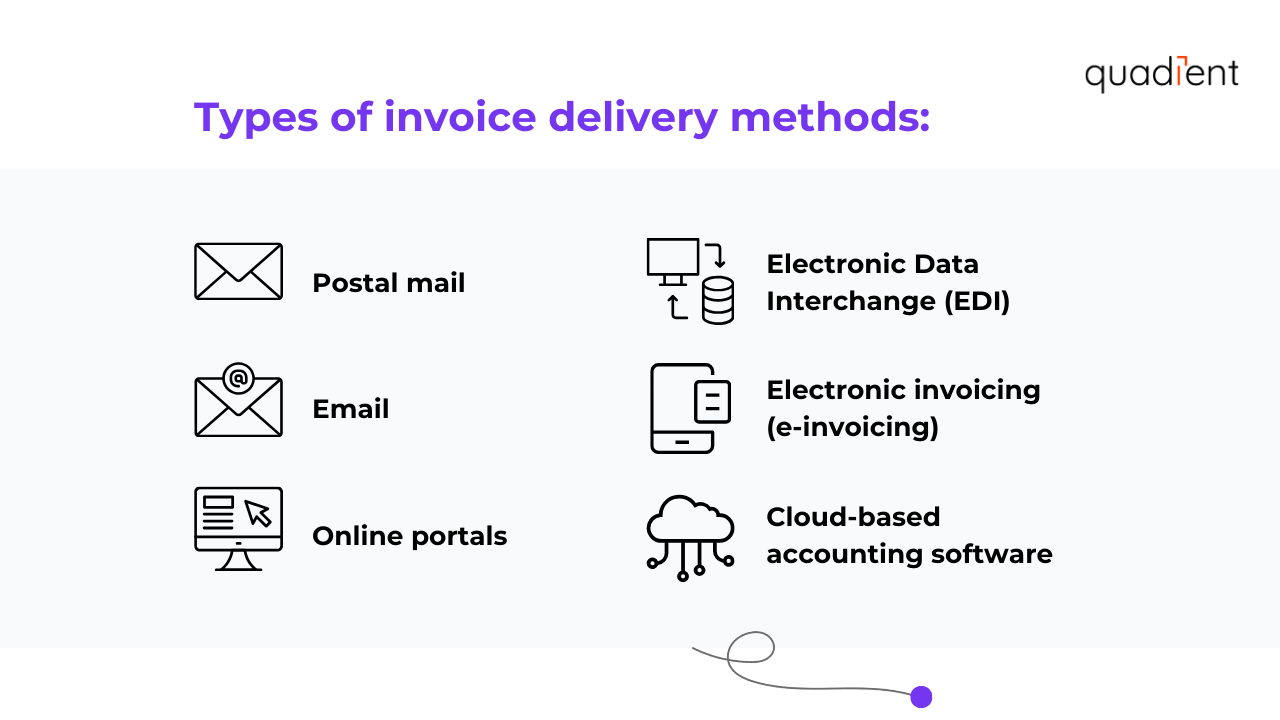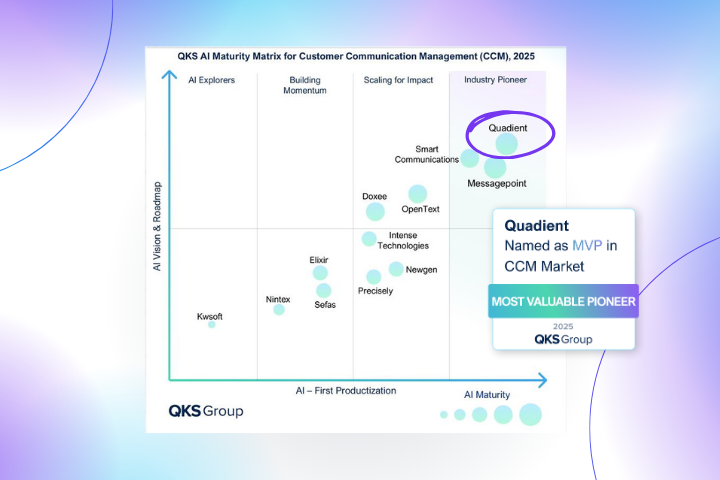Introduction
Gone are the days of relying solely on traditional mail to send invoices. Today, businesses have a range of digital options at their disposal. Compared with traditional invoicing methods, these modern approaches streamline processes, optimize cash flow, and enhance customer satisfaction.
This article delves into the different invoice delivery methods for accounts receivable and their key advantages. This information will help you choose the method that best aligns with your goals.
Types of invoice delivery methods
There are several methods of invoice delivery:
- 1. Postal mail
- 2. Email
- 3. Online portals
- 4. Electronic Data Interchange (EDI)
- 5. Electronic invoicing (e-invoicing)
- 6. Cloud-based accounting software

Postal mail
In the past, businesses usually mailed invoices to the recipient's physical address.
Key advantages of invoice delivery by postal mail include the following:
- Tangible: Recipients receive a physical document they can hold and review. This provides a tactile experience that some people prefer.
- Formal: Delivering invoices by mail adds a sense of formality. This can be beneficial when dealing with clients or industries that value traditional communication methods.
- Avoids email issues: Postal mail circumvents email filters that might cause important emails to end up in spam folders.
- Compliant: Certain industries and regions have invoicing legalities or regulations, making postal mail the preferred method to ensure compliance.
Email has become the standard way to deliver invoices. This method involves sending PDF invoices or a link to an online payment platform to the recipient's email address.
Key advantages of invoice delivery via email include the following:
- Instant delivery: Invoices reach recipients almost immediately, reducing delays in payment processing.
- Cost savings: Email invoicing reduces paper, printing, and postage expenses.
- Tracking and confirmation: Businesses can track sent invoices and receive proof of delivery, ensuring transparency and reducing disputes.
- Eco-friendly: Email invoicing is environmentally friendly, reducing paper usage and promoting a sustainable business approach with a smaller carbon footprint.
Online portals
Online portals are web-based platforms that allow businesses to create, manage, and send electronic invoices. Customers can log in to access their invoices and make payments.
Key advantages of invoice delivery via a billing portal include the following:
- Accessible: Online portals streamline invoice management by facilitating convenient access, sharing, and retrieval from any location with an internet connection.
- Customization and branding: Online portals typically provide options to customize invoices with your company logo, colors, and branding elements. Additionally, many portals allow for the customization of invoices with targeted messaging.
- Security: Invoice delivery via online portals secures sensitive information through encryption, access controls, and secure storage.
- Eco-friendly: Online portals contribute to a sustainable business operations approach since they reduce paper usage.
- Cost savings: Like other digital delivery methods, portals reduce the costs of handling paper invoices.
Electronic Data Interchange (EDI)
Electronic Data Interchange (EDI) is an automated invoice delivery method that exchanges structured electronic data between businesses.
Key advantages of invoice delivery via EDI include the following:
- Efficient and accurate: EDI eliminates manual data entry, reducing errors in invoicing data and accelerating invoice processing.
- Cost savings: EDI automates invoice processing, reducing administrative costs and expediting payment cycles.
- Get paid faster: Quick and accurate invoice processing results in faster payment.
- Security: EDI employs encryption and secure transmission protocols to protect sensitive financial information during transit.
- Eco-friendly: EDI reduces paper usage, contributing to a greener approach to business operations.
Electronic Invoicing (e-invoicing)
E-invoicing is the direct exchange of electronic invoices between the buyer and seller's billing and payment systems.
Key advantages of e-invoicing include the following:
- Efficient: E-invoicing automates invoicing, reducing manual handling and paperwork, leading to faster processing times and fewer errors.
- Faster payment processing: E-invoicing delivers invoices instantly, reducing the time between submission and payment receipt.
- Accuracy and security: Automated data extraction makes electronic invoicing less prone to errors. It ensures security through secure encryption and digital signatures.
- Eco-friendly: E-invoicing reduces paper consumption and waste, helping businesses lower their carbon footprint.
- Compliance: E-invoicing solutions adhere to industry standards and regulatory requirements, ensuring tax and reporting compliance.
- Customer satisfaction: Efficient and accurate invoicing processes improve customer and supplier relationships.
Cloud-based accounting software
Many businesses use cloud-based accounting software to generate and send invoices digitally to customers.
Key advantages of cloud-based accounting software include the following:
- Accessible: Users can access financial data from any device with an internet connection.
- Cost-effective: Cloud-based accounting software operates on a subscription-based model, offering cost savings compared to on-premise software.
- Backups and security: Automated backups and robust security measures protect financial data.
- Integration: Cloud-based accounting software integrates with other cloud-based applications, streamlining workflows and reducing data entry errors.
- Scalable: Cloud accounting software can scale up or down based on a business's changing needs.
You can explore other solutions that might benefit your invoicing methods:
- Benefits of Automated Invoice Processing: Implementing automated invoice processing within your cloud-based accounting software can further streamline your invoicing process, reducing manual effort and minimizing errors.
- Client Document Portals: Enhance customer satisfaction and facilitate seamless communication by integrating client document portals with your cloud-based accounting software.
- Payments with Invoicing Solutions: Simplify payment processing for both you and your clients by integrating payment options directly into your invoicing software.
- Electronic Invoice Presentment and Payment: Maximize efficiency and reduce delays by adopting electronic invoice presentment and payment methods, seamlessly integrated with your chosen invoicing solution.
Conclusion
Choosing a suitable invoice delivery method is crucial for optimizing your business's financial operations. You can determine which option best fits your needs by considering your business requirements, budget, and technological capabilities. Embrace the future of invoicing and transform your financial operations for improved efficiency and customer satisfaction.







